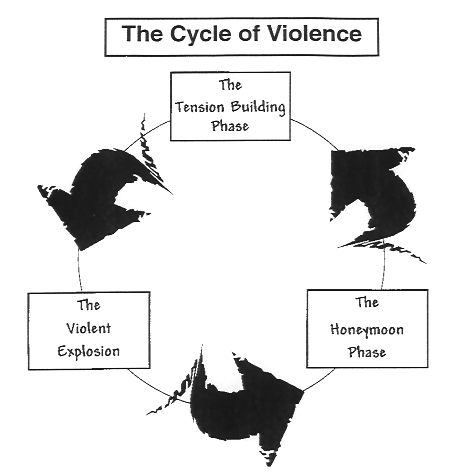| Home Page
About Page
Domestic Violence
Sexual Assault
Child Sexual Abuse
Dating Violence
Guest Book
Survivors
Teen Dating Violence
Date Rape
Volunteer!
Domestic Violence
Links
|
|
|
Domestic Violence
Domestic violence is a significant and intimate relationship in which one person abuses the other person. Domestic violence can occur in relationships whether the couple is: living together, previously lived together, is married, divorced, seperated. Has children or does not have children. Is a heterosexual or homosexual couple.
Violence in relationships can take a number of forms. The abuse ranges from verbal attacks to sexual assault.
|
 TYPES OF ABUSE
Verbal abuse
TYPES OF ABUSE
Verbal abuse
Intimidation
Emotional Abuse
Isolation
Physical Abuse
Sexual Abuse
Economic Abuse
Denial of Rights |
|
Statistics
1. Every 9 seconds in our country a woman is battered by her intimate partner.
2. 95% of all domestic violence assaults are committed by men.
3. 85% of batterrers as children watched domestic violence occur in their own homes and/or experienced child physcial/sexual abuse themselves.
4. 50% of all willful homicides of females are committed by a past or present intimate partner.
5. 63% of all boys, ages 11-20, who are arested for murder, have killed the man who was assaulting their mother.
6. 4,000+ murders each year are domestic violence related.
7. Battered women represent 1 out of 5 cases seen in emergency rooms.
8. 25%-30%, of all females who are battered are pregnant.
9. There are nearly 4,000 shelters for abused animals in our country. There are only 1,200 shelters for battered women and their children.
|
|
Myths of Domestic Violence.
Domestic violence only affects a few people.
Battered women want to be beaten.
Domestic violence occurs only in poor urban areas.
Once a victim, always a victim.
His abuse is caused by...It's not his fault.
Children need their father, even if he is a batterer.
Drugs and alcohol cause the battering.
Stress causes the battering.
THE MOST DANGEROUS TIME FOR A WOMEN IN AN ABUSIVE RELATIONSHIP IS WHEN SHE IS TRYING TO LEAVE.
Abuse is about power and control. The abuser does not want to lose control of the victim. When they think the victim is attempting to leave them they begin to panic. They are losing control.
A women who plans on leaving should have some type of plan:
Have extra keys for a vehicle somewhere outside or within easy reach.
Keep a bag of clothes for you and your children with a neighbor, friend, relative. Someone you can trust.
Try to keep extra change, for phone calls is necessary.
Talk to someone, do not keep the violence a secret.
Have an escape plan set up for you and your children and practice it regularly. This can also save lives in case of a fire or other emergency.
If violence should break out, try to stay out of the kitchen and bathroom. There are knives in the kitchen that can be used as a weapon. He can corner you in a bathroom.
Make the home as safe as possible, changing locks, adding deadbolts, getting an apartment on the ground level.
Keep copies of ID's for you and your children in a safe place. Possibly with your extra clothes.
Be aware of your surroundings at all times.
Park your car under a light, if you can, in a parking lot.
Locate your police and sheriff's departments. You may have to get to them in a hurry. If you feel you are being followed go immediately to the police or sheriff's department. WHich ever is closer.
Set up a signal with your neighbor. SO that they can call for help if you need them to.
Give a picture of your batterer to your work place. Along with a description of the vehicle that he is driving.
These are only some of the things you can do to try to stay safe and get out of an abusive home in a hurry.
|
 Cycle of Violence
Domestic Violence usually occurs in three phases:
Cycle of Violence
Domestic Violence usually occurs in three phases:
--The Tension Building Phase
--The Violent Explosion
--The Honeymoon Phase
The Tension Building Phase---is the phase in which victims may describe as "walking on eggshells." The batterer's anger and rage is growing to a climax, and most of the victim's energy is directed toward trying to prevent a violent episode. The victim knows that a violent explosion is about to happen, they just do not know when.
The Violent Explosion---This phase may last from two to twenty-four hours. The incident is usually triggered by some outside force and is acted out in the home. A most intense degree of destructiveness and violence is involved in this phase that results in physical abuse. Over the course of the relationship the physical abuse usually escalates.
The Honeymoon Phase---This phase the batterer expresses guilt and regret. He may appear pitiful and sorry, promising her anything to get her to stay with him or come back home. He may become the kind and loving man she first fell in love with.
Over the course of the relationship the victim usually finds that the "Honeymoon phase" gets shorter and shorter and that the "Tension Building phase" gets longer and longer.
|

WHY WOMEN STAY
There are many reasons why women stay in an abusive relationship.
1. No income, they are not employed, do not have access to bank accounts.
2. No place to go. They have no family in immediate area. Do not know about local shelters or safe houses.
3. Face a decline in living standards for themselves and their children.
4. They are isolated from friends, family and co-workers. This isolation is caused by either a jealous and possessive abuser, or to hide signs of abuse from the world.
5. Fear, the abuser threatens violence, or actually attacks when attempts to leave are made.
6. They not only fear for their lives but the lives of their children, friends, and family.
7. Clergy and counselors often have the goal of "saving" the marriage, rather than the goal of stopping the violence.
8. Many victims do not believe divorce or seperation is an option.
9. Many victims believe that even a violent two parent home is better than a single parent home. "I don't want to take them away from their father."
10. Victims are taught that they are responsible for making their marriage work. Failure of the marriage equals failure as a person.
11. Many victims rationalize the abuser's behavior by blaming stress, alcohol, drugs, work, themselves, unemployment, etc.
12. The abuser rarely beats the victim all the time. During the non-violent phases, they rationalize their abuser is good until something bad happens and they have to "let off steam."
(The above was taken from "STOP THE VIOLENCE" published by L.A.W. Publications. Page 5)
|
|
|


